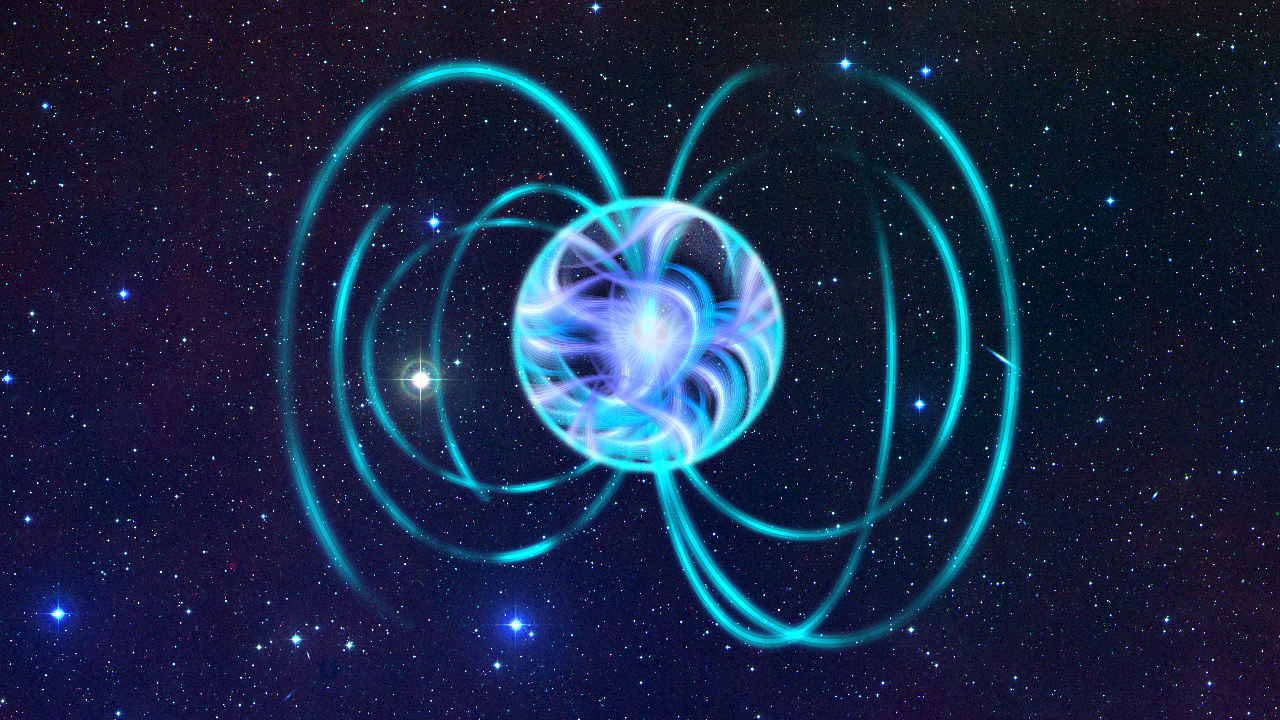The chance discovery with ESA’s INTEGRAL observatory, in 2004, of highly energetic X-rays emanating from a young neutron star with an extremely strong magnetic field, provided scientists with a challenge: how to explain how these objects, also known as magnetars, produce such energetic non-thermal radiation. A new, comprehensive study of one particular magnetar, in which astronomers discovered a socalled ‘timing glitch’, may provide the key to homing in on the processes at play in the extreme environments of these exotic stars.
Astronomers already know that the strong magnetic field of a magnetar acts like a brake, slowing down the rate at which the neutron star spins. Occasionally, this smooth deceleration is disrupted by a sudden increase in spin rate, known as a timing glitch. A “star quake” near the magnetar’s surface is thought to be responsible for the timing glitch and it is often followed by a large outburst of radiation – the emissions that are associated with SGRs and AXPs.

Until a chance encounter in 2004, the persistent emission from AXPs was assumed to be present only at low-energy X-rays. “Nobody saw any reason to look for emission from AXPs above 10 keV,” says Wim Hermsen, also from SRON Netherlands Institute for Space Research, and a co-author of the study. “It was only because of the large field of view of INTEGRAL that we serendipitously detected an AXP emitting non-thermal emission that extended up to about 200 keV.”
Following that discovery, theoreticians have been trying to explain this unexpected high-energy emission. “How this magnetic energy is transformed into non-thermal energetic X-rays is still strongly debated,” says Hermsen. To help solve this mystery, the astronomers wanted to gather data in the low- and high-energy X-ray bands from a magnetar undergoing an outburst. Given the rarity of these objects – only about 20 have been discovered to date – and the unpredictable nature of these outbursts, this was quite a challenge.
Jackpot
Luck was on their side when in January 2009 an armada of space missions, including ESA’s INTEGRAL observatory, all spotted extreme ‘bursting activity’ – hundreds of short duration bursts that typically lasted 0.1 s – from magnetar 1E 1547.0-5408. Using data collected by INTEGRAL and by NASA’s Swift and Rossi X-ray Timing Explorer satellites, Kuiper and his colleagues carried out a detailed study of how the emissions from the magnetar varied over a 27-month period.

Shortly after starting their analysis, the astronomers hit the jackpot when they discovered a very peculiar timing glitch – the most dramatic sudden change, by 70%, in the spin down of a magnetar that has ever been detected. This timing glitch was accompanied by an outburst of low- and high-energy X-rays.
High-energy unpulsed emission was detected immediately after the timing glitch, which suggests that the magnetar has a “corona” of charged particles surrounding the neutron star. “Unlike ordinary pulsars, which only emit radiation along field lines originating from their poles, magnetars apparently have such strong fields that particles can be accelerated to produce X-rays all around the neutron star,” says Hermsen.
Transient high energy pulse
The team’s data also revealed an unexpected discovery: a new transient high-energy pulse – a distinct new feature in the pulse profile – that decayed to undetectable levels in about 300 days. This detection may prove key to unravelling the processes at play in the extreme environment of a magnetar. “This case is unique; it is the first time that we have seen the creation of both pulsed and unpulsed luminous X-ray emission after a star quake,” says Kuiper. Unlike the unpulsed high-energy X-rays, the pulsed emission wasn’t released immediately; it was only evident in the observations 11 days after the timing glitch. The astronomers propose that this delay is consistent with one particular model of the many that have been created to describe these exotic stars.
In a model put forward in 2009 by Andrei Beloborodov from Columbia University in New York, USA, a star quake could twist the magnetic field lines that are anchored to a star’s surface; these then gradually untwist, releasing magnetic energy and producing radiation. However, Beloborodov’s model shows that the untwisting would occur in a peculiar way. Following a delay after the star quake, the untwisting would create a quasi-stable bundle of twisted field lines above the magnetic pole – this could explain the origin of the observed transient emission, say the astronomers.
Reference publication
Kuiper, L., Hermsen, W., den Hartog, P.R., Urama, J.O., 2012, Temporal and spectral evolution in X- and gamma-rays of magnetar 1E 1547.0-5408 since its October 2008 outburst: the discovery of a transient hard pulsed component after its January 2009 outburst, ApJ 748 133.doi: 10.1088/0004-637X/748/2/133
Contacts
Lucien Kuiper, email: L.M.Kuiper@sron.nl, phone:+31 88 777 5875. Wim Hermsen, email:W.Hermsen@sron.nl, phone:+31 88 777 5871


